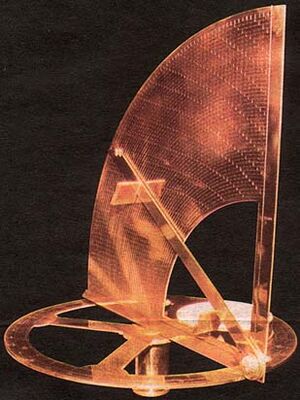Nonius (nonfiction)
A nonius is a measuring tool used in navigation and astronomy named in honor of its inventor, Pedro Nunes (Latin: Petrus Nonius), a Portuguese author, mathematician and navigator. The nonius was created in 1542 as a system for taking finer measurements on circular instruments such as the astrolabe.
The nonius was used to improve the astrolabe's accuracy. This consisted of a number of concentric circles traced on an instrument and dividing each successive one with one fewer divisions than the adjacent outer circle. On a standard scale of 90 degrees, there are an additional 44-45 concentric circles with each divided into a specific unit size such that a scale unit on position n had an arc of 90/n degrees. Thus, the outermost quadrant would comprise 90° in 90 equal divisions, the next inner would have 89 divisions, the next 88 and so on. When an angle was measured, the circle and the division on which the alidade fell was noted. A table was then consulted to provide the exact measure.
The astronomer Tycho Brahe applied the nonius to the astronomic quadrant.
The system was eventually adapted into the vernier scale in 1631 by the French mathematician Pierre Vernier.
In numerically controlled machines, the nonius is part of several absolute encoders that measure linear or rotational displacements.
In the News
Fiction cross-reference
Nonfiction cross-reference
External links:
- Nonius (device) @ Wikipedia
